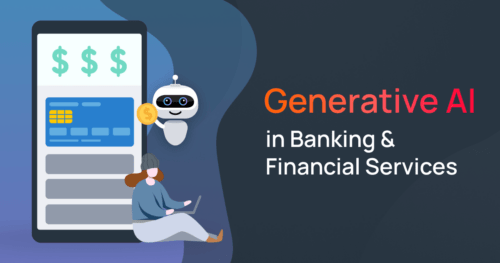An Introduction to Generative AI in Banking and Finance
The banking industry has long been familiar with technological upheavals, and generative AI in Banking stands as the most recent influential development. This advanced machine learning technology, adept at sifting through vast data volumes, can generate distinct insights and content. Implementing gen AI initiatives involves strategic road mapping, talent acquisition, and upskilling, as well as managing new risks and ensuring effective change management.
Leveraging Generative AI in banking to collect and interpret financial data on a large scale enables bank managers to make knowledgeable choices, offer personalized services, detect fraud and suspicious transactions, evaluate risks, and undertake a variety of other essential tasks.
Moreover, this technology significantly enhances customer experiences by ensuring services are closely tailored to individual needs and preferences. Let’s explore more details and specific use cases of Generative AI in banking and financial services.
What Does Generative AI Mean to Banking?
Generative AI, powered by advanced machine learning models, including gen AI models, is revolutionizing the banking and financial sectors. This technology is reshaping the landscape of AI and automation in banking by introducing efficient solutions to automate previously time-consuming tasks. From conversational AI in Banking that enhances customer interactions to generative AI and the development of large language models for financial services, the application of AI in banking and finance is broadening, offering innovative avenues for automation and improved service delivery.
But what are the specific applications? We’ll highlight the top seven use cases. These include reshaping AI customer service, that employs AI for enhanced fraud detection, using machine learning to predict financial trends, and customizing banking services for individual needs. Join us as we unravel how these technologies are shaping the future of finance.

Generative AI Use Cases in Banking
Generative AI tools are transforming the banking industry. The online payment platform Stripe, for example, recently announced its integration of Generative AI technology into its products. This is just one example of numerous integrations of AI in fintech.
While we’re still in the early stages of the Generative AI revolution powered by machine learning models, there’s undeniable potential for vast changes in banking. Verticals within financial services predicted to undergo significant transformation include retail banking, SMB banking, commercial banking, wealth management, investment banking, and capital markets. The high interest in gen AI solutions in the banking industry highlights its transformative potential and practical applications. Let’s explore the seven use cases of Generative AI in modern banking in the USA, Canada, and India.
1. Detect and Prevent Fraud
One major use case for gen AI technology in banking is preventing fraud. According to Cybercrime Magazine, the global cost of cybercrime was $6 trillion in 2021, and it’s expected to reach $10.5 trillion by 2025. To protect their business, banks must take data security seriously.
Many banks have large fraud prevention departments. However, these can be costly to run and maintain, and in some cases, they aren’t very effective.
Like utilizing Generative AI in Insurance for fraud detection, banks can use it to track transactions in terms of location, device, and operating system. It can then flag any anomalies or behavior that doesn’t fit expected patterns. From there, bank personnel can review the suspicious behavior and decide if it deserves further investigation. That way, banks don’t need to comb through transactions manually, which takes longer and is prone to human error.
In addition, Generative Artificial Intelligence can continually mine synthetic data and update its detection algorithms to keep up with the latest fraud schemes. This proactive approach helps banks anticipate fraudulent behavior before it happens.
Banks can also use Generative AI to require users to provide additional verification when accessing their accounts. For example, an AI chatbot could ask users to answer a security question or perform a multi-factor authentication (MFA).
The point is there are many ways that banks can use Generative AI to improve customer service, enhance efficiency, and protect themselves from fraud.
2. Manage Risk and Improve Credit Scoring
Banks can also use gen AI tools to manage credit risk assessment. Risk management is essential to avoiding financial disasters and keeping the business running smoothly. When trained on historical data, Generative AI can detect and identify potential risks and financial risks and provide early warning signs so that banks have time to adapt and prevent (or at least mitigate) losses.
The same goes for credit scoring. Banks are in the business of evaluating borrowers applying for loans. Instead of relying on traditional credit score elements to determine creditworthiness, banks can have machine learning algorithms and AI to analyze vast amounts of data from multiple sources and create a more holistic financial picture of loan applicants.
3. Make Financial Forecasts
Another benefit of training AI on historical financial data is that it can help banks make financial forecasts and enable synthetic data generation.
Generative AI models can identify patterns and relationships in the data and even run simulations based on hypothetical scenarios. From there, it can help banks evaluate a range of possible outcomes and plan accordingly.
In short, Generative Artificial Intelligence can look to the past to help banks make better financial decisions about the future and create synthetic data for robust analyses of risk exposure.
4. Personalize Marketing Efforts
Like all businesses, banks need to invest in targeted marketing to stand out from the competition and gain new customers. But this is easier said than done. It takes a lot of deep customer analysis and creative work, which can be costly and time-consuming.
However, Artificial Intelligence can help speed up your marketing efforts. How? By analyzing your customers’ preferences and online behavior. From there, it can split your leads into segments, for which you can create different buyer personas. That way, you can tailor your marketing campaigns to different groups based on market conditions and trends.
You can also use gen AI solutions to help you create targeted marketing materials and track conversion and customer satisfaction rates. Then perform A/B tests to see what’s working and what’s not. Over time, your marketing ROI will improve.
5. Boost the Customer Experience and Customer Satisfaction
As a bank, you don’t just want to gain new customers; you also want to retain existing ones, and gen AI tools can help you achieve this. And to do that, you must always improve customer service and invest in creating a good customer experience.
When powered with natural language processing (NLP), enterprise chatbots can provide human-like customer support 24/7. It can answer customer inquiries, provide updates on balances, initiate transfers, and update profile information. But it can also respond to more complex inquiries.
For example, a customer may need help understanding how much of a mortgage they can afford. When AI models are provided with the relevant details such as interest rate, down payment amount, and credit score, Generative AI can quickly provide an accurate home purchasing budget. In this way, it can conversationalize complex math questions.
Generative Artificial Intelligence can also educate on other financial tasks and literacy topics more generally by answering questions about credit scores and loan practices—all in a natural and human-like tone.
In addition, AI personalizes customer experience. How? By analyzing customer data and then making personalized product recommendations. For example, it can recommend a credit card based on a customer’s spending habits, financial goals, and lifestyle. This makes for a convenient way for customers to pick the right card. Generative AI can also help you cross-sell and upsell products this way.
According to a study by Forrester, 72% of customers think products are more valuable when they are tailored to their personal needs.
Let’s explain what is conversational AI. Conversational AI a subset of Artificial Intelligence, can enhance user accessibility by simplifying the provision of multilingual support through virtual assistants and aiding those with disabilities through text and voice navigation options.
Using conversational AI in the banking sector has become increasingly prevalent in recent years. Major financial institutions such as Bank of America and Wells Fargo have integrated this technology as the backbone of their AI virtual assistants. These AI-driven platforms improve customer experience by providing instant responses and personalized interactions and streamlining numerous banking processes.
6. Generate Financial Advice for Customers Based on Proprietary Data
Some financial institutions like mortgage brokers or investment companies provide financial advice to their customers using gen AI technology. This can be one of the best Generative AI use cases for financial service companies. Such financial advisors and businesses can combine human expertise with the power of AI to give consumers more comprehensive and customized financial plans.
First, you must train the Generative AI on your customers’ financial goals, risk profiles, income levels, and spending habits. From there, you can use it to make personalized budgeting and saving recommendations.
The same goes for investing. Generative AI can make suggestions based on customers’ financial goals, income, and time horizons. For financial planners, this can lead to smarter investment & wealth management and trading decisions.
For example, Generative AI can assist in optimizing portfolios, managing risk, and executing trades. It empowers asset managers to make data-driven that aligns with their client’s financial goals and risk tolerances.
7. Summarize Large Documents
Banks are notorious for dealing with massive amounts of paperwork. But manually sorting through, analyzing, and signing off on various financial documents and applications can take a lot of time and money. To cut operational costs, banks can have gen AI models comb through large volumes of documents to identify important data or summarize them for review.
For example, Generative Artificial Intelligence can be used to summarize customer communication histories or meeting transcripts. This can save time when dealing with customer concerns or collaborating on team projects.
Trends in Generative AI for Banking Globally
The use of Generative AI and machine learning in banking is not limited to the US or Canada. Financial institutions and banks in India are also utilizing enterprise chatbots and machine learning for AI-powered banking applications such as voice assistants and fraud detection.
As an example of modern banking in India, SBI Card, a payment service provider in India, leverages Generative AI and machine learning to enhance their customer experience.
The use of Generative AI and machine learning in banking is not limited to the US or Canada. Financial institutions and banks in India are also utilizing enterprise chatbots and machine learning for AI-powered banking applications such as voice assistants and fraud detection. Global adoption of gen AI initiatives involves strategic road mapping, talent acquisition, and managing new risks.
As an example of modern banking in India, SBI Card, a payment service provider in India, leverages Generative AI and machine learning to enhance their customer experience.

Future of Generative AI in Banking and Financial Institutions
Generative AI is poised to revolutionize the banking and financial sectors, offering innovative solutions to enhance operational efficiency and customer experiences. This advanced technology, capable of processing and interpreting vast amounts of data, enables banks to automate complex tasks, provide personalized services, and detect fraudulent activities with greater accuracy. The future of AI in banking includes transformative applications that enhance operational efficiency and customer experiences.
In the future, generative AI will play a pivotal role in shaping financial services by enabling predictive analytics for risk management, enhancing credit scoring systems, and offering customized financial advice. Furthermore, the integration of generative AI with existing banking systems will streamline operations, reduce costs, and improve decision-making processes. As banks continue to adopt and refine this technology, they will be better equipped to meet the evolving needs of their customers and maintain a competitive edge in the financial industry.
However, the deployment of generative AI in banking comes with its challenges, including data privacy concerns and the need for regulatory compliance. Financial institutions must ensure that their AI systems are transparent, secure, and aligned with industry standards to maximize the benefits of this transformative technology.
Challenges, Limitations, and Risks of Using Generative AI in Banking
Of course, working with Generative AI in the banking sector has its challenges and limitations. It’s not a magic bullet that can do everything. It’s just a tool.
For example, Generative AI should be used cautiously when dealing with sensitive customer data. It also shouldn’t be relied upon to stay compliant with different government regulations, such as the General Data Protection Regulation (GDPR) or the California Consumer Privacy Act (CCPA).
Another limitation of Generative AI is that it can produce incorrect results if it’s fed with poor or incomplete data due to AI hallucination. So you always need to ensure your data is accurate and up to date. Otherwise, it could lead to poor financial decision-making.
As a rule of thumb, you should never let Generative AI have the final say in loan approvals and other important decisions that affect customers. Instead, have it do all the heavy lifting and then let financial professionals make the ultimate decisions. All that said, Generative AI can still be a powerful banking tool if you know how to use it properly.
Getting Started with Generative AI in the Financial Services
At the end of the day, banks must learn to embrace Generative AI to survive. Not adopting the tool is letting your competitors get the upper hand. With Generative AI still in its infancy, now is the time to learn how to implement it in your business. Your business can then evolve with it to start with Generative AI step by step.
Here at Aisera, we offer Generative AI tools tailored to different industries, including the financial services and banking industries. If you want to take your financial business to the next level, we can help.
Our self-service AI banking solutions include tools like account setup and management, payment tracking, transaction history viewing, stolen and lost card replacements, dispute transaction management, and much more.
Feel free to contact us today or book an AI demo! We look forward to learning more about your business and matching it with the right Generative AI tools!

